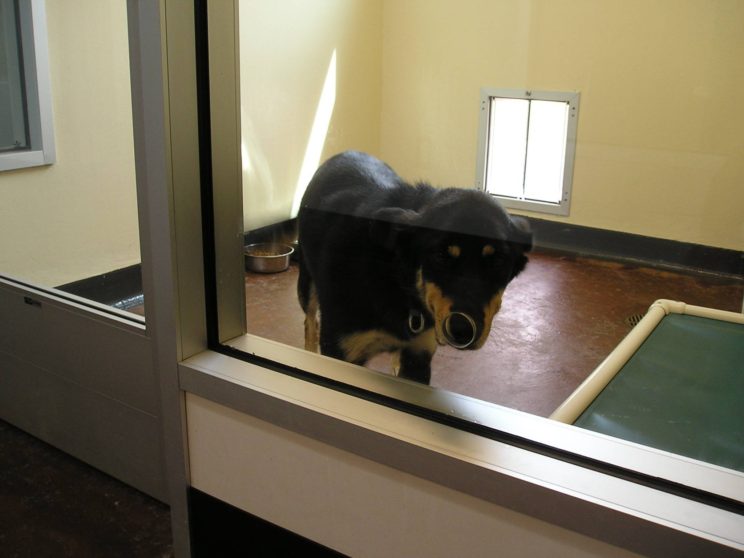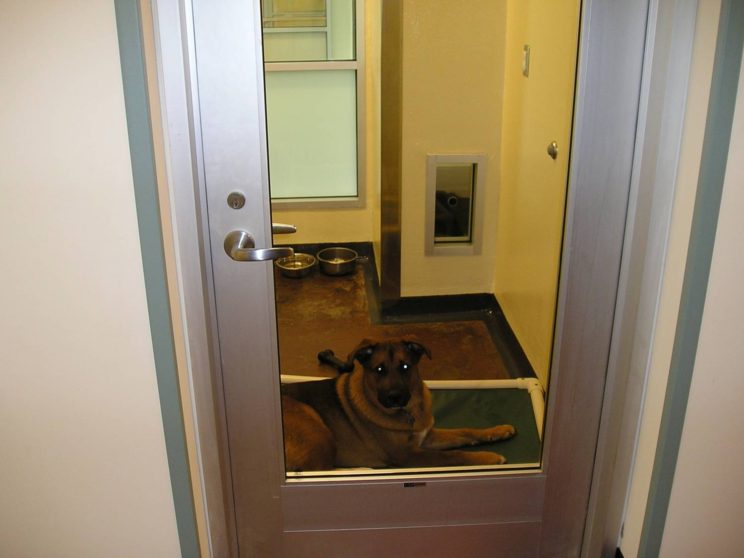Healthy minds, healthy bodies, healthy relationships. And sniff holes.

It will surprise no one that many “dogs experience fear and anxiety immediately upon admission” to a shelter. These are dogs who are used to living in homes or even on the street and then find themselves kenneled in a strange, loud, often dirty, and stressful environment, separated from the home or place and people with whom they are accustomed.
But what is surprising is that the same is not necessarily true for long-term kenneling. Conventional wisdom says that the longer a dog stays in a shelter, the more likely he or she is to become “kennel crazy.” Indeed, opponents of No Kill often denigrate shelters who have dogs for weeks, months, and in some cases a year or more arguing that doing so is “warehousing.” But studies show that that is not true as long as dogs are stimulated, well socialized and exercised.
To imply that No Kill means warehousing, therefore, is a cynicism which has only one purpose: to defend those who fail to save lives from public criticism and public accountability by painting the alternative as even darker. Moreover, it isn’t even true that No Kill means long stays for animals. At the open admission No Kill shelter I oversaw, the average length of stay for animals was eight days, we had a return rate of less than two percent, we reduced the disease rate by 90 percent from the prior administration, we reduced the killing rate by 75 percent, no animal ever celebrated an anniversary in the facility, and we saved well over 90 percent of the animals (over 95% using comparative save rate calculations). Many other No Kill shelters have similar lengths of stay. The average length of stay at all open admission shelters with save rates better than 90% is roughly 14 days or the length of time a dog might spend at a boarding facility while their family is on vacation.
But what if it was longer? Would it matter? Of course, there is no substitute for a home of one’s own. But a study of dogs across a dozen shelters in the U.K. found that it wouldn’t necessarily matter so long as the dogs were being socialized: “dogs adapt to the kennel environment over time” and “environmental enrichment helps animals to cope with their environments.” In other words, newly admitted dogs tend to be stressed. Dogs who only get the basics: food, water, and shelter are stressed. But dogs who are given enrichment are not stressed and the longer they are in the shelter, the less stressed they become.
How should shelters provide such enrichment for dogs? The study suggests that they be provided “mental and physical stimulation, time out of the kennel and close interaction with people.” In other words, the same things that are important to us and which I constantly harangue my kids about: healthy bodies, healthy minds, and healthy relationships.
Two other things, of note, stood out. The first is that the study found that fewer but longer exercise periods were more beneficial to dogs, rather than more frequent ones of shorter duration. The second, and the more important one, is that dogs should be able to see (and I would argue, interact) outside their kennel in order to “reduce frustrated attempts to see what is going on beyond their kennel.”
Here, too, conventional wisdom has failed dogs. Most shelters are designed so that dogs can’t see people and other dogs in neighboring kennels in the hopes that this will reduce barking. Where there is glass, it is usually opaque. Where there are adjoining kennels, they are usually concrete. Where there are fences or bars, they usually face a wall (and include a “do not touch the animals” sign for people walking by). These are mistakes as they are not conducive to dog welfare or their intended purpose of reducing frustration. In fact, they exacerbate it.
Fifteen years ago when I directed the construction of a shelter in Central New York, I worked to make sure the environment we created to house dogs met their needs. It was built with clear glass so dogs could see outside their kennels, added sniff goals so dogs could smell and touch, and added windows and sniff holes between kennels so dogs could also interact with their doggy neighbors.

It is nice to see the science finally catching up with what anyone who has ever lived with and loved a dog already knows: they are highly social animals who do not thrive in solitary confinement.
The study is available here.
————-
Have a comment? Join the discussion by clicking here.